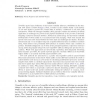98 search results - page 4 / 20 » Causal Time Series Analysis of Functional Magnetic Resonance... |
TMI
2002
13 years 4 months ago
2002
It has been shown that the difference of squares cost function used by standard realignment packages (SPM and AIR) can lead to the detection of spurious activations, because the mo...
IJON
2008
13 years 5 months ago
2008
Real-world data sets such as recordings from functional magnetic resonance imaging often possess both spatial and temporal structure. Here, we propose an algorithm including such ...
ICASSP
2009
IEEE
13 years 2 months ago
2009
IEEE
In this paper, a novel non-stationary model of functional Magnetic Resonance Imaging (fMRI) time series is proposed. It allows us to account for some putative habituation effect a...
ICASSP
2011
IEEE
12 years 8 months ago
2011
IEEE
Functional magnetic resonance imaging (fMRI) is a popular tool for studying brain activity due to its non-invasiveness. Conventionally an expected response needs to be available f...
JMLR
2011
12 years 12 months ago
2011
A widely agreed upon definition of time series causality inference, established in the seminal 1969 article of Clive Granger (1969), is based on the relative ability of the histor...

